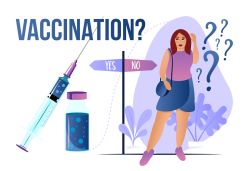Strategies for Communicating With Vaccine-Hesitant Parents of Pediatric Patients: Provide Information in Plain Language
Laura M. Cascella, MA, CPHRM
The proliferation of misinformation and the confusion about vaccines often highlight the broader issue of health literacy and patient comprehension, or in the case of pediatrics, parent comprehension of health information.
People of all ages, races, cultures, incomes, and educational levels struggle with health literacy, and many adults have trouble understanding and using the health information that is routinely available in healthcare facilities.1 Language barriers, cultural values, religious beliefs, and other factors also might hinder the communication process and prevent understanding.
To address these issues, pediatricians and other pediatric providers can take an approach that emphasizes clear communication and plain language. Strategies to consider include:
| Helpful Tip |
|---|
| Many credible organizations and agencies offer free plain language materials about vaccines. Examples include the American Academy of Pediatrics, HealthyChildren.org, the Immunization Action Coalition, and the Centers for Disease Control and Prevention (CDC). |
- Providing parents who are new to the practice with a welcome brochure that explains the organization's mission, philosophy on vaccinations, and commitment to high-quality patient care.
- Using layman's terms and avoiding medical jargon when discussing vaccinations with parents.
- Presenting the most important information first, and repeating key concepts.
- Gauging parental understanding using a technique such as teach-back to ensure that parents completely understand clinical information and recommendations.
- Offering culturally appropriate, plain language educational materials that are developed or selected based on the needs of the patient population.
- Providing parents with an office visit summary that contains a plain language recap of what was discussed and any instructions for follow-up care.
Remember that the principles of plain language focus on communication that is clear, concise, and logically organized. Plain language is not "dumbing down" information, and the tone of the communication should not sound condescending.
Learn more about health literacy, plain language, and cultural competence at plainlanguage.gov and the CDC's Health Literacy Basics webpage. MedPro's articles Acknowledging Cultural Competence as a Key Element of Health Literacy and Patient-Centered Care and Using Plain Language to Support Patient Engagement and Patient-Centered Care also offer helpful tips for developing a communication approach that is mindful of health literacy barriers.
For more strategies on addressing vaccine hesitancy, see Communicating Effectively With Vaccine-Hesitant Parents of Pediatric Patients.
Endnotes
1 U.S. Department of Health and Human Services, Office of Disease Prevention and Health Promotion. (2010). National action plan to improve health literacy. Washington, DC: Author. Retrieved from https://health.gov/our-work/health-literacy/national-action-plan-improve-health-literacy; Centers for Disease Control and Prevention. (2013). The state of aging and health in America 2013. Atlanta, GA: Author. Retrieved from www.cdc.gov/aging/pdf/state-aging-health-in-america-2013.pdf; Centers for Disease Control and Prevention. (2021, May 21 [last reviewed]). Talking points about health literacy. Retrieved from www.cdc.gov/healthliteracy/shareinteract/TellOthers.html








